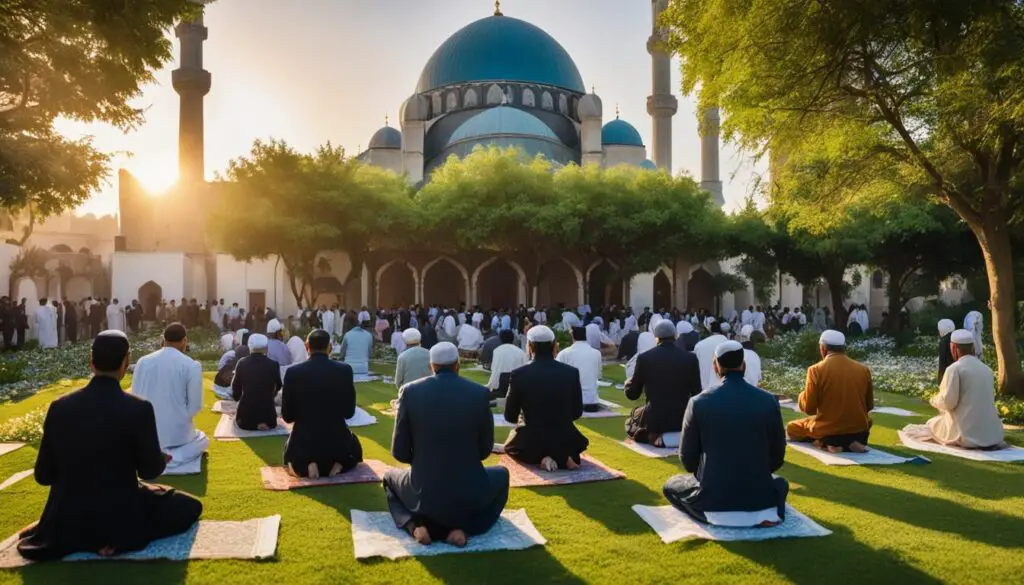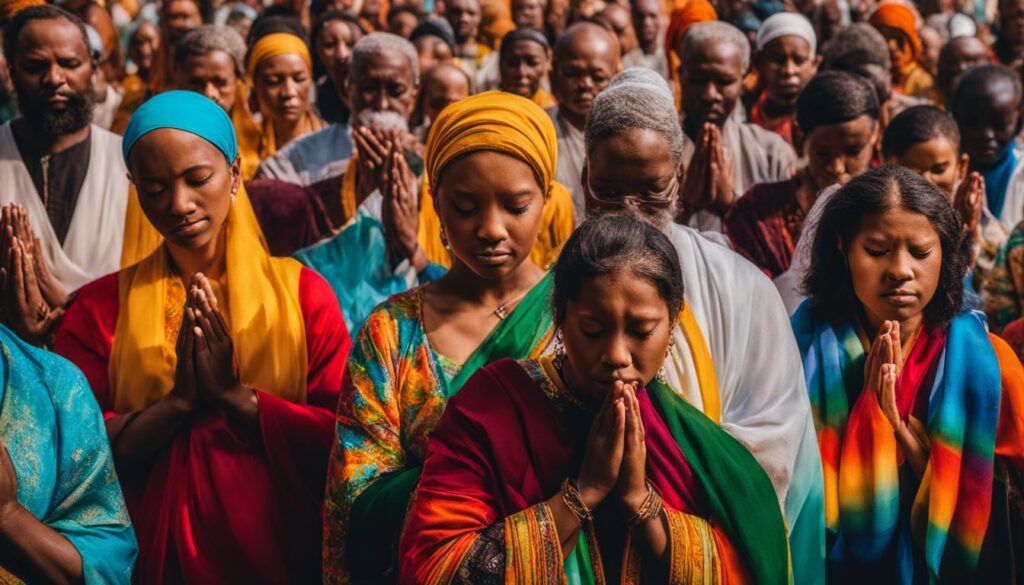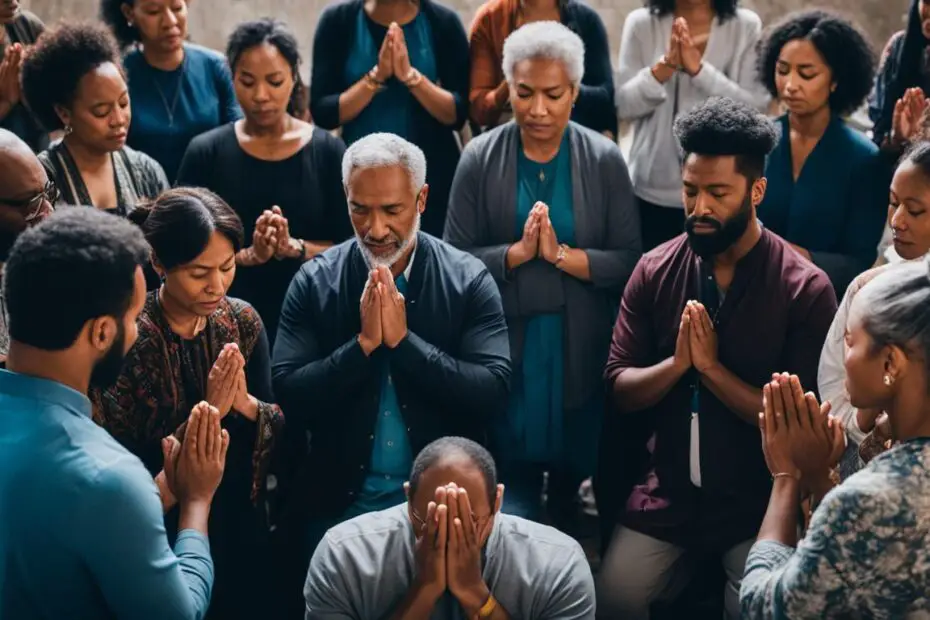Prayer is a universal language that transcends borders, cultures, and religions. It is a powerful tool that brings people together, fostering understanding, respect, and unity. In today’s diverse world, cross cultural prayer serves as a bridge that connects individuals from different faiths, allowing them to share in the beauty and wisdom of global prayer traditions.
Cross cultural prayer encompasses a wide range of diverse prayer practices and traditions from around the world. It celebrates the multiculturalism inherent in our society, showcasing the richness and depth of various faiths. From Christian hymns to Islamic call to prayer, from Buddhist chants to Hindu mantras, each prayer practice has its own unique significance and offers a glimpse into the spiritual traditions of different cultures.
Key Takeaways:
- Cross cultural prayer promotes understanding, respect, and unity among people of different faiths.
- It embraces the beauty of diversity in prayer practices and customs.
- Interfaith group prayer serves as a bridging cultural practice that fosters unity among individuals from diverse backgrounds.
- Prayer has a positive impact in bridging differences and fostering collaboration in the workplace.
- Addressing logistical and spiritual challenges is essential in creating inclusive environments for cross cultural prayer.
The Beauty of Diversity in Prayer
Diversity is a fundamental characteristic of cross-cultural prayer. It encompasses the richness of different religious traditions, customs, and beliefs. Embracing and respecting the diversity in prayer practices allows for intercultural and interfaith prayer experiences that promote inclusivity and understanding among people of different backgrounds.
Religious diversity in prayer offers a profound opportunity to explore and appreciate the multitude of ways in which individuals and communities connect with the divine. It encourages us to broaden our perspective and recognize the inherent wisdom and beauty that exists in different prayer customs.
When we embrace diverse prayer practices, we cultivate an environment that fosters intercultural prayer experiences. These experiences not only deepen our understanding of various faith traditions but also provide valuable opportunities for personal growth and spiritual exploration.
Embracing different prayer customs allows us to break down barriers and build bridges of understanding and empathy. Interfaith prayer experiences are a powerful reminder of our shared humanity and the universal longing for connection and transcendence.
When we pray alongside individuals from different backgrounds, we are reminded of the interconnectedness of all spiritual journeys. It is in this tapestry of diverse voices, united in prayer, that we find the true beauty of religious diversity.
By embracing the beauty of diversity in prayer, we create sacred spaces where individuals can come together in communal worship, celebrating the unique expressions of their respective faith traditions. These intercultural prayer experiences deeply enrich our lives and foster a greater sense of unity and interconnectedness.
Take a moment to reflect on the magnificent tapestry of prayer practices and customs that exists in the world. Each tradition reflects the unique cultural and spiritual heritage of its followers, offering a glimpse into the boundless ways in which humanity seeks meaning, connection, and guidance.

Let us celebrate the beauty of diversity in prayer and embrace the transformative power of intercultural prayer experiences. Together, we can build bridges of understanding and create a world where religious diversity is not merely tolerated, but celebrated as a testament to the richness of human spirituality.
Interfaith Group Prayer as a Bridging Cultural Practice
Interfaith group prayer has emerged as a powerful practice for bridging cultural divides and fostering understanding among individuals from diverse backgrounds. By bringing together participants from various faith traditions, inclusive prayer rituals create a shared space for unity and mutual respect.
Interfaith group prayer sessions serve as a way to build bridges, enabling individuals to find common ground and connect on a spiritual level. These gatherings transcend religious boundaries, emphasizing the universal aspects of our shared human experience.
Inclusive prayer rituals are designed to accommodate the diverse beliefs, customs, and languages of participants, nurturing an atmosphere of inclusivity and acceptance. They provide an opportunity for individuals to learn from and appreciate one another’s traditions, fostering a deeper sense of empathy and understanding.
“In interfaith group prayer, we come together as a diverse community, acknowledging and celebrating our differences while finding solace in our shared longing for spiritual connection.”
Interfaith group prayer allows individuals to witness and experience the unique expressions of faith from various traditions. This firsthand exposure creates opportunities to challenge preconceived notions, debunk stereotypes, and cultivate meaningful relationships.
The Transformative Power of Interfaith Group Prayer
Through interfaith group prayer, individuals gain a deeper appreciation for the interconnectedness of all spiritual paths and the universal values they espouse. This transformative experience can lead to a greater sense of unity, empathy, and compassion among participants.
By engaging in interfaith group prayer, individuals contribute to the collective healing and understanding of diverse communities. They contribute to a world where differences are celebrated, and barriers are broken, paving the way for a more inclusive and harmonious society.

“In interfaith group prayer, we bridge the gaps that divide us, and together, we illuminate the path towards a more compassionate and unified world.”
The Impact of Prayer in Bridging Differences Among Employees
Many organizations are now recognizing the profound impact of interfaith prayer in bridging differences among employees. In today’s diverse workforce, embracing diversity in the workplace is crucial for fostering a harmonious and inclusive environment.
Research suggests that interfaith group prayer can play a significant role in cultivating a more collaborative and understanding work environment. By engaging with different prayer customs, employees from various faith traditions can come together, promoting mutual respect and unity.
“Prayer has the power to transcend religious boundaries and create a shared experience, fostering a sense of community and togetherness among employees.”
When employees have the opportunity to express their spirituality and engage in interfaith prayer within the organization, it not only strengthens the bonds between individuals but also enhances overall well-being and job satisfaction.
By embracing diversity in prayer practices and creating space for interfaith prayer, organizations can create an atmosphere that acknowledges and respects the spiritual needs and beliefs of all employees. This can lead to increased productivity, improved communication, and a greater sense of belonging within the workplace.
The power of interfaith prayer in bridging differences among employees goes beyond the spiritual realm. It has the potential to foster empathy, cultivate understanding, and break down barriers that may exist due to cultural or religious differences.
By embracing interfaith prayer in organizations, businesses have the opportunity to create a multicultural work environment where employees feel valued, respected, and empowered. This can result in a diverse workforce that is united, supportive, and committed to their collective goals.

Embracing the richness of diversity through interfaith prayer in organizations can transform the workplace into a space that celebrates differences and promotes unity. It is an essential step towards building a inclusive and harmonious working environment that reflects the spirit of interconnectedness and cooperation.
Addressing Logistical and Spiritual Challenges in Cross Cultural Prayer
When it comes to cross cultural prayer, there are significant logistical and spatial challenges that need to be addressed. Finding appropriate spaces and ensuring that language and prayers are inclusive in interfaith gatherings can be complex.
One of the logistical challenges of cross cultural prayer is the availability of suitable spaces. Different prayer practices and traditions often require specific environments or accommodations. It can be difficult to find a space that caters to the needs and customs of multiple faiths.
The language used in interfaith gatherings is another important consideration. Communicating prayers and messages in a way that is respectful and inclusive to all participants is essential. In some cases, translation services may be required to ensure that everyone can fully engage in the prayer experience.
To address these challenges, alternative forms of prayer and deliberately designed “multi-faith” spaces are being explored. These spaces aim to overcome logistical barriers by providing inclusive environments for prayerful experiences. They offer a neutral ground where individuals from different faith traditions can come together in unity and shared spirituality.
Furthermore, interfaith organizations and communities are working to develop guidelines for appropriate language and prayers in interfaith gatherings. These guidelines help ensure that prayers are respectful, inclusive, and embrace the diverse beliefs and customs of participants.
“Inclusive prayer experiences foster understanding, respect, and unity among people of different faiths”
By addressing the logistical and spiritual challenges of cross cultural prayer, we can create opportunities for meaningful and enriching interfaith experiences. These efforts promote inclusivity and harmony, allowing individuals from diverse backgrounds to come together in prayer.
Alternative Forms of Prayer
Just as faith traditions vary, so too do the ways in which individuals connect with the divine. Alternative forms of prayer provide a platform for individuals from different backgrounds to express their spirituality in ways that are meaningful to them. These can include practices such as meditation, chanting, or silent contemplation. By offering a range of prayer options, we can ensure that everyone feels welcome and comfortable in an interfaith setting.
Deliberately Designed “Multi-Faith” Spaces
Creating deliberately designed “multi-faith” spaces helps to overcome the logistical challenges of finding suitable prayer environments. These spaces are thoughtfully designed to accommodate the needs of various faith traditions, providing a neutral ground that promotes inclusivity and understanding. They can incorporate elements such as prayer mats, sacred symbols, and quiet areas for personal reflection. By embracing the diversity of prayer practices, these spaces foster a greater sense of unity among participants.
Guidelines for Appropriate Language and Prayers
Establishing guidelines for appropriate language and prayers in interfaith gatherings is essential for ensuring that all participants feel respected and included. These guidelines encourage the use of inclusive language and promote a deep understanding of the diverse beliefs and customs represented. They help facilitate meaningful and authentic prayer experiences that reflect the values and traditions of all involved.
Logistical and Spiritual Challenges in Cross Cultural Prayer
| Challenge | Solution |
|---|---|
| Finding appropriate spaces | Designing deliberately designed “multi-faith” spaces that cater to diverse prayer practices |
| Addressing language barriers | Developing guidelines for appropriate language and translation services |
| Ensuring inclusive prayers | Promoting diverse forms of prayer and encouraging inclusive language |
In conclusion, addressing logistical and spiritual challenges is crucial for creating inclusive and meaningful cross cultural prayer experiences. By exploring alternative forms of prayer, designing multi-faith spaces, and establishing guidelines for appropriate language and prayers, we can overcome these challenges and foster unity, understanding, and respect in interfaith gatherings.

Celebrating Differences as a Spiritual Understanding
A spiritual understanding of diversity goes beyond acknowledging the differences among human beings. It embraces these differences as a reflection of God’s beneficence and creativity, revealing the intricacies of the divine plan. Each person, with their unique background and experiences, contributes to the tapestry of life, adding depth and beauty to our collective existence. By celebrating these differences, we honor the manifestation of the divine in all its forms.
Embracing diversity in prayer practices and customs allows for a deeper appreciation of the multifaceted nature of spirituality. Just as the colors of a rainbow blend harmoniously to create a breathtaking sight, diverse prayer traditions intertwine to form a mosaic of faith and devotion. Through interfaith dialogue and engagement, we gain insights into the various paths people take to connect with the divine, nurturing our own spiritual growth in the process.
“In diversity, there is beauty and strength. It is through embracing our differences that we realize the magnificence of the human experience.” – Unknown
When we celebrate differences as a spiritual understanding, we shift our perspective from one of separation to one of unity. We recognize that the breadth of human experience is a reflection of God’s infinite wisdom and love. Each prayer becomes a thread in the fabric of our collective longing for transcendence, regardless of the language spoken or the posture assumed. These diverse expressions of devotion weave together to form a tapestry of spiritual connection.
The Journey of Self-Discovery
Embracing diversity in prayer practices and customs invites us on a journey of self-discovery. As we interact with individuals from different faith traditions, we learn not only about their spiritual practices but also about ourselves. Through deep listening and open-heartedness, we witness the beauty of humanity reflected in the diversity of religious beliefs.
This journey of self-discovery requires humility and a willingness to let go of preconceived notions. It challenges us to confront our biases and expand our understanding of what it means to be spiritual beings. By seeking common ground while honoring our differences, we cultivate a profound appreciation for the interconnectedness of all existence.
| Benefits of Celebrating Differences | Implications for Spiritual Growth |
|---|---|
|
|
As we celebrate our differences, our spiritual understanding deepens, and we gain a broader perspective on the divine. We realize that the reflected facets of divinity found in others are but reflections of the same divine essence within ourselves. It is through embracing diversity that we come to understand and embrace the fullness of God’s beneficence in the world.

The Role of Interfaith Prayer in Times of Crisis
In times of crisis, interfaith prayer serves as a powerful force that brings people together, transcending religious boundaries and fostering unity, healing, and support.
Whether it be the aftermath of natural disasters or the trauma caused by acts of violence, interfaith prayer gatherings provide a space where individuals from different faith traditions can find solace and draw strength from one another. Coming together in prayer during these times of adversity reminds us of our common humanity and the interconnectedness of our lives.
In interfaith prayer, people set aside their differences and join in collective supplication, seeking comfort, guidance, and hope. It is a time when religious and spiritual practices converge, demonstrating that despite our diverse beliefs, we can find common ground in our shared desire for healing and restoration.
Moreover, interfaith prayer acts as a transformative force, enabling communities to come together and provide aid to those affected by crisis. It unifies individuals in their commitment to helping others, crossing societal divides to offer support, resources, and solace to those in need. Through interfaith prayer, we witness the power of compassion and unity, transcending any differences that may exist.
Interfaith prayer creates a sacred space where people can find comfort, peace, and strength amidst the chaos of crisis. It embodies the belief that by joining our hearts and minds in prayer, we can overcome the most challenging of circumstances and emerge stronger, united, and resilient.
As we navigate through turbulent times, interfaith prayer serves as a testament to humanity’s unwavering resilience, compassion, and capacity to unite in the face of adversity. It reminds us that no matter our individual beliefs or backgrounds, we are all interconnected, and we share a collective responsibility to support and uplift one another.
Interfaith Prayer in Times of Crisis
| Benefits of Interfaith Prayer | Examples |
|---|---|
| Provides a space for unity and healing | Interfaith prayer vigils held after acts of violence |
| Fosters support and solidarity | Interfaith prayer gatherings following natural disasters |
| Transcends religious boundaries | Joint prayers during societal crisis |
| Strengthens interfaith relationships | Collaborative prayer initiatives during humanitarian crises |
During times of crisis, interfaith prayer acts as a powerful symbol of unity and resilience. It reminds us of our interconnectedness and the strength that can be found by coming together in prayer, transcending religious boundaries and promoting a sense of collective responsibility. In the darkest of times, interfaith prayer shines as a beacon of hope, illuminating the path towards healing, compassion, and a brighter future.
Interfaith Worship: Exploring the Limits and Possibilities
Interfaith worship invites us to delve into the realms of possibility, where diverse faith traditions converge, allowing for the sharing of intimate moments of spiritual communion. It raises questions about the limits and boundaries that exist when people from different faiths come together in worship, and the possibilities that emerge when we open our hearts and minds to understanding.
Authentic interfaith worship is a tapestry woven from the threads of diverse traditions, each unique and distinct in its own right. It honors the individual contributions of each participant, embracing their ways and language, while celebrating the differences that enrich our collective spiritual tapestry.
In this realm of interfaith worship, we find ourselves both teachers and learners, offering our prayers and rituals while being receptive to the prayers of others. It is an opportunity for us to listen, learn, and foster a deep appreciation for different faith traditions, understanding that the spiritual journey is as diverse as the people who embark upon it.
“Authentic interfaith worship can involve each participant contributing in the ways and language distinctive to their own tradition while listening, learning, and respecting the prayers of others.”
Intertwined in this exploration of interfaith worship is the recognition that shared moments of spiritual communion can foster unity, compassion, and interconnectedness. Through humble and respectful engagement, interfaith worship allows us to find common ground, to discover the universal elements that connect us to something greater than ourselves.
As we immerse ourselves in interfaith worship, we embark on a journey of spiritual growth and understanding. We begin to see the beauty in the tapestry of different faith traditions, appreciating the countless ways in which humanity seeks connection with the divine.
It is within the realm of interfaith worship that we witness the transformative power of unity, the transcendence of boundaries, and the celebration of our shared humanity. It is through these shared moments of sacred communion that we embrace the full richness of the human experience and expand our capacity for love and compassion.
The Poetry of Interfaith Worship
Interfaith worship is a poetic symphony of diverse voices joining together in harmonious prayer. Each participant brings their unique melody to the chorus, creating a tapestry of spiritual expression that resonates with the beauty of our shared existence.
As we lift our voices in prayer, we become a living testament to the power of understanding and respect. In this sacred space of interfaith worship, walls crumble, barriers dissolve, and we discover a profound interconnectedness that unites us beyond religious boundaries.
The Path Forward: Embracing Understanding
Interfaith worship challenges us to broaden our perspectives, to step outside the confines of our own traditions, and to embrace the understanding that emerges when we bridge the gaps between faith communities. It is a journey of growth, one that leads us to a deeper appreciation of the human experience and the myriad ways in which we seek meaning.
Through interfaith worship, we can cultivate a world where understanding thrives, where differences are celebrated, and where spiritual communion knows no bounds. It is a testament to our collective journey towards unity, respect, and love.
As we explore the limits and possibilities of interfaith worship, we are reminded of the profound beauty that emerges when we come together to share intimate moments of spiritual communion, to listen, learn, and understand different faith traditions. In the tapestry of our collective worship, we discover the power of unity, the transformative potential of shared reverence, and the infinite possibilities that arise when hearts and minds converge in the pursuit of spiritual understanding.
Interfaith Worship in National Holidays and Commemorations
Interfaith worship holds a special place during national holidays and commemorative events, providing an opportunity for people of different faiths to join together in prayer, harmony, and reflection. These occasions serve as powerful reminders of the unity and diversity within our communities, as individuals from various religious backgrounds gather to observe shared values and express their devotion.
One such significant commemoration is Thanksgiving, a day when people of diverse faith traditions gather to give thanks for abundance, blessings, and the spirit of togetherness. During interfaith worship services held on Thanksgiving, prayers for peace, gratitude, and unity are offered, emphasizing the shared values of compassion, love, and appreciation.
A similar sentiment is observed during Martin Luther King, Jr. Day, where individuals from various religious backgrounds come together to commemorate the life and legacy of this influential figure in the civil rights movement. Interfaith worship services held on this day often focus on justice, equality, and the promotion of peace, highlighting the ongoing pursuit of Dr. King’s dream for a more just and inclusive world.
Interfaith worship during national holidays and commemorative events serves as a powerful example of the collective strength and resilience that emerges when diverse faith traditions unite in prayer. It showcases the ability of individuals to set aside differences and come together in pursuit of shared ideals, fostering a sense of belonging, understanding, and peace.
Prayers for Peace and Commemorative Services
Prayers for peace are a central aspect of interfaith worship in national holidays and commemorative events. They serve as a powerful reminder of the universal desire for harmony and the collective responsibility we bear in working towards a more peaceful world.
“Peace is not merely a distant goal that we seek, but a means by which we arrive at that goal.”
– Martin Luther King, Jr.
These prayers often express a deep longing for unity and understanding among different cultures and religions. Through interfaith worship, individuals reaffirm their commitment to promoting peace, justice, and reconciliation, recognizing that it is through collective efforts that lasting change can be achieved.
Commemorative services during national holidays provide an opportunity to honor and remember significant historical events or influential figures. Interfaith worship conducted during these services allows individuals to express their gratitude, pay homage, and reflect on the impact of these significant moments in history. It serves as a unifying force that celebrates diversity and unity, fostering an environment of respect, appreciation, and shared values.
The Power of Interfaith Worship in National Holidays and Commemorations
Interfaith worship during national holidays and commemorative events holds immense power in reinforcing the bonds of shared humanity and nurturing respect for diverse religious traditions. It reminds us that despite our different backgrounds and beliefs, we are connected by a common thread of spirituality and a desire for greater understanding and harmony.
Through interfaith worship, individuals inspire one another, uplift hearts, and strengthen the fabric of our communities. It is a testament to the power of collective prayer, where people from different faiths join together to seek blessings, express gratitude, and renew their commitment to a better, more compassionate world.
The Role of Interfaith Prayer in Social Activism
Interfaith prayer has emerged as a powerful force in the realm of social activism, transcending religious divides and bringing people together to promote justice, peace, and equality. In the face of societal challenges, individuals from diverse faiths unite, using prayer as a catalyst for change. These interfaith prayer vigils and gatherings serve as a poignant expression of solidarity, reinforcing shared values and aspirations.
A Spiritual Collective for Justice
In times of social unrest and injustice, interfaith prayer becomes a unifying force that brings people together to raise their voices and hearts for justice. Communities of various faith traditions join hands, invoking the divine guidance and healing necessary to address the critical issues plaguing society. Through these collective prayer experiences, individuals are reminded of their interconnectedness and the fundamental rights and dignity that every human being deserves.
“Coming together to advocate for justice is a truly transformative experience. We may have different beliefs and practices, but our shared commitment to social change is what unites us. By praying together, we tap into a deeper spiritual energy that fuels our actions and strengthens our resolve. We stand in solidarity, guided by the belief that our combined efforts can create a more just and compassionate world.”
Interfaith prayer in social activism represents a beautiful mosaic of diverse voices joining together to demand positive change. These prayer gatherings provide a nurturing space for reflection, inspiration, and motivation, encouraging participants to actively engage in peaceful protests, advocacy, and community initiatives. By incorporating prayer into their activism, individuals bring a spiritual dimension to their actions, infusing them with a sense of purpose and divine guidance.
Praying for Justice: A Catalyst for Transformation
Prayer serves as a catalyst for transformation both within individuals and in the wider society. When people of different faiths unite in prayer for justice, their collective intention amplifies the call for equality, systemic reform, and the recognition of human rights. The power of interfaith prayer lies in its ability to inspire empathy, compassion, and a renewed commitment to creating a more equitable world.
Interfaith prayer in social activism is not merely a symbolic gesture but a practice that fosters connection, understanding, and collaboration among diverse communities. It provides a platform for meaningful dialogue, shared learning, and the nurturing of relationships built on mutual respect and common goals. By praying together, individuals break down barriers, challenge stereotypes, and cultivate lasting solidarity.
Prayer as a Catalyst for a Just Future
Through interfaith prayer, individuals harness the collective energy of diverse faith traditions to envision and strive for a more just future. Prayer becomes a call to action, instilling a sense of responsibility, empathy, and solidarity among activists. It reinforces the belief that positive change is possible and that each person has a role to play in shaping a more equitable society.
The Impact of Interfaith Prayer Gatherings
| Benefits of Interfaith Prayer in Social Activism | Examples |
|---|---|
| Unity and solidarity among diverse communities | Prayers for racial justice, gender equality, and LGBTQ+ rights |
| Empowerment and inspiration for activism | Interfaith prayer vigils for gun control and environmental protection |
| Bridge-building and mutual understanding | Interfaith prayer gatherings for immigration reform and refugee rights |
| Healing and resilience in the face of adversity | Prayer ceremonies in response to natural disasters and humanitarian crises |
Interfaith prayer gatherings have the potential to transform social activism, infusing it with a spiritual dimension that fosters unity, resilience, and compassion. By coming together to pray for justice, people of different faiths create a vibrant tapestry of collective action, working hand in hand to address the pressing challenges of our time.
Spaces for Cross Cultural Prayer and Worship
In response to the need for inclusive spaces for cross cultural prayer and worship, organizations and communities are creating multi-faith worship spaces. These spaces aim to accommodate the diverse prayer practices and customs of different faith traditions, promoting inclusivity and fostering understanding among individuals of various backgrounds.
Multi-faith worship spaces provide a safe and welcoming environment where people of all faiths can come together to engage in prayer, reflection, and spiritual communion. These spaces recognize and celebrate the beauty of religious diversity, allowing individuals to express their unique religious practices while fostering a sense of unity and interconnectedness.
By creating multi-faith worship spaces, communities and organizations promote inclusivity and strengthen interfaith relationships. These spaces serve as a physical manifestation of the ideals of respect, acceptance, and tolerance, providing a common ground for individuals from different faith traditions to come together and learn from one another.
“Multi-faith worship spaces symbolize our commitment to embracing diversity and nurturing a sense of belonging for all individuals, regardless of their religious backgrounds. They serve as a reminder that no matter our differences, prayer has the power to unite us all.”
These spaces often feature architectural designs that incorporate elements from various religious traditions, creating a visually captivating environment that reflects the shared spiritual heritage of humanity. From intricate stained glass windows to serene meditation gardens, these spaces offer a tranquil and sacred atmosphere for individuals to connect with their inner selves and the divine.
In addition to providing a physical space for cross cultural prayer and worship, multi-faith worship spaces also serve as centers for dialogue, education, and interfaith engagement. They host workshops, seminars, and interfaith celebrations that aim to deepen understanding and promote harmony among individuals of different backgrounds.
With the growing recognition of the importance of diversity and inclusivity, the demand for multi-faith worship spaces continues to rise. Communities and organizations around the world are actively working towards the creation of these spaces, ensuring that individuals from all faith traditions have a welcoming place to practice their religious customs and traditions.
Benefits of Multi-Faith Worship Spaces
Creating multi-faith worship spaces offers several benefits:
- Promotes inclusivity and understanding among individuals of different faith traditions.
- Fosters interfaith relationships and strengthens community bonds.
- Celebrates the diversity of religious practices and customs.
- Provides a spiritual haven where individuals can find solace and peace.
- Facilitates dialogue, education, and interfaith engagement.
Conclusion
Cross cultural prayer is a transformative practice that holds immense power in bridging faiths worldwide. Throughout this article, we have explored the beauty of diversity in prayer, the role of interfaith group prayer in fostering unity, and the impact of prayer in addressing differences in the workplace. We have also discussed the challenges faced in cross cultural prayer and the spiritual understanding that celebrates differences.
Interfaith prayer has proven to be a valuable tool in times of crisis, bringing people together to find solace and support. It has also been instrumental in social activism, uniting individuals from different religious backgrounds in the pursuit of justice and equality. The creation of inclusive spaces for cross cultural prayer and worship further emphasizes the importance of fostering understanding and inclusivity.
In conclusion, cross cultural prayer has shown us the power of shared spiritual expression across diverse faiths. By embracing diversity, promoting understanding, and fostering respect, we can strengthen interfaith relationships and contribute to a more harmonious and connected world. Let us recognize the beauty in our differences and come together in prayer, uniting in our common humanity.
FAQ
What is cross cultural prayer?
Cross cultural prayer refers to the inclusion and celebration of various prayer practices and traditions from different cultures and religions. It acknowledges and embraces the diversity of faith traditions and customs in order to foster understanding and unity among people of different backgrounds.
How does cross cultural prayer promote inclusivity?
Cross cultural prayer promotes inclusivity by recognizing and respecting the diversity in prayer practices and beliefs. It provides opportunities for intercultural and interfaith prayer experiences, allowing individuals from different backgrounds to come together in prayer and fostering mutual understanding among them.
How does interfaith group prayer contribute to unity?
Interfaith group prayer serves as a bridging cultural practice within multi-faith groups. It brings individuals from diverse backgrounds together, helping them find common ground and foster unity. Inclusive prayer rituals that involve participants from various faith traditions promote mutual understanding and respect.
How can embracing diversity in prayer practices benefit organizations?
Embracing diversity in prayer practices can benefit organizations by contributing to a more harmonious and productive work environment in a diverse workforce. Research suggests that interfaith group prayer can lead to better collaboration and understanding among employees, fostering a sense of inclusion and respect for different faith customs.
What are the challenges faced in cross cultural prayer?
Cross cultural prayer often faces logistical and spatial challenges, including finding appropriate spaces for diverse prayer practices and addressing the use of language and prayers in interfaith gatherings. However, alternative forms of prayer and the creation of deliberately multi-faith spaces are being explored to overcome these challenges and create inclusive environments for prayerful experiences.
How does embracing diversity in prayer relate to spiritual understanding?
Embracing diversity in prayer practices and customs is part of a spiritual understanding that recognizes the beauty of differences among human beings. It involves celebrating these differences as a reflection of God’s beneficence and creativity, leading to a deeper appreciation of the divine in all its manifestations.
How does interfaith prayer serve during times of crisis?
Interfaith prayer gatherings provide a space for unity, healing, and support during times of crisis, such as natural disasters or acts of violence. Coming together in prayer transcends religious boundaries and highlights the common humanity we all share, offering solace and strength in difficult times.
What is the role of interfaith worship in understanding different faith traditions?
Interfaith worship raises questions about sharing intimate moments of spiritual communion with people of different faith traditions. While opinions may vary, many believe that authentic interfaith worship involves each participant contributing in ways distinctive to their own tradition while also listening, learning, and respecting the prayers of others, thereby deepening understanding and promoting interfaith dialogue.
When is interfaith worship observed?
Interfaith worship is often observed during national holidays and commemorative events. For instance, occasions like Thanksgiving and Martin Luther King, Jr. Day bring people of different faiths together to offer prayers for peace, express gratitude, or celebrate the life and legacy of a prominent figure. Interfaith worship during these events showcases the diversity and unity of religious traditions.
How does interfaith prayer contribute to social activism?
Interfaith prayer has become a significant component of social activism, as people of different faiths often gather to pray for justice, peace, and equality. Interfaith prayer vigils and gatherings demonstrate solidarity and support for various causes, bringing together individuals who share common values and aspirations.
Are there spaces specifically designed for cross cultural prayer and worship?
Yes, in response to the need for inclusive spaces, organizations and communities have started creating multi-faith worship spaces. These spaces aim to accommodate the diverse prayer practices and customs of different faith traditions, promoting inclusivity and fostering understanding among individuals of various backgrounds.
What is the power of cross cultural prayer?
Cross cultural prayer has the power to bridge faiths worldwide and create a tapestry of shared spiritual expression. By embracing the beauty of diversity, promoting understanding and unity, and providing opportunities for individuals from different faith traditions to come together in prayer, cross cultural prayer strengthens interfaith relationships and contributes to a more harmonious and connected world.








